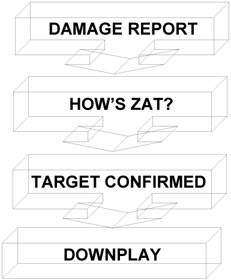The Basic Steps in Handling Hinges
You know the hinge categories, types, strategies, and tactics. The following four steps in Exhibit 8-1 show how to combine them so that you can effectively handle hinges. The case studies at the end of this section also highlight the logistics and strategies of each step. The steps are as follows:

Exhibit 8-1: Basic steps for handling hinges.
Step 1. Damage Report
In the damage report step, the salesperson evaluates the impact of the hinge.
-
Pause and implement Silence Is Golden. If you say to yourself, "Uhoh, I wonder how I am going to get out of this one?" you waited the recommended five seconds.
-
Use the Safety Zone strategy and the Pat from Saturday Night Live tactic and evaluate the impact or potential damage of the hinge. Ask yourself, "Do I understand how the hinge impacts their goals, my sales strategy, product, or call for action? Is it just a request for more information?" Formulate your clarifying question on what you need to know to answer these questions.
Example
-
Olivia: I really do not want to exceed our $50,000 budget.
-
Steven asks himself: What is determining the $50,000 budget limit; how will that affect their goals or product selections; what does "really" mean?
Those answers hold the key to understanding and handling the hinge.
Step 2. How's Zat?
This step clarifies the impact of the hinge.
-
Ask a clarifying question concerning the hinge's impact without confirming a negative. This sometimes requires two or three open-ended questions before you can verify that you have a measurable reply.
Example
-
Steven: Why is that? (Clarifying question)
-
Olivia: Exceeding the $50,000 figure means getting corporate approval, which could delay the project a year.
Step 3. Target Confirmed
In this step, the salesperson verifies the impact of the hinge.
-
Verify your understanding of how they feel the hinge affects their goals or your product selections without agreeing with them.
-
Verifying requires yes-or-no questions. If necessary, phrase your clarifying question so that it relates to their goals (safety zone).
-
The customers' responses should be a challenge that states, "Here's my concern. If you make it go away, we can move forward."
Example
-
Steven: So, your concern is that you might have to wait a year if you need to get corporate approval and delay receiving the projected cost savings.
-
Olivia: Exactly, I do not want to wait a year to get the savings. (She verifies hinge and issues her challenge.)
Step 4. Downplay
In this step, the salesperson minimizes the impact of the hinge.
-
Use the following three tactics to apply for the now-defined hinge by:
-
Explaining. Provide additional information or clarification to "explain away" a customer's misconception or misinterpretation. Use this tactic during any of the four MPs.
Example

-
Olivia: Exactly, I do not want to wait a year to get the savings.
-
Steven explains: We can use progressive billing to spread the price over a two-year budget period. You wouldn't exceed the $50,000 level in a single year and you wouldn't require corporate approval.

-
-
Outweighing. You remedy an actual liability by showing how the overall benefits in achieving their goals "outweigh" their concerns. Depending on whether you mentioned specific products, you use this tactic during MP 2: Cement Solution or MP 3: Implement Agreement phases. This strategy requires measurable benefits. Outweighing is like an accounting ledger with credits and debits—with the total sum carrying the most weight.
Example

-
Olivia: Exactly, I do not want to wait a year to get the savings.
-
Steven outweighs: The project exceeds your $50,000 budget. (It is a fact, and he hits it head on). However, if I can help you demonstrate to corporate how waiting a year delays saving $180,000 (lost opportunity costs or the costs of doing nothing) in operating expenses, will that bring about an approval this year?

-
-
Revising. You offer a new call for action in MP 3: Cement Solution because the filters in MP 2: Measure Potential were not fully qualified. Your original proposed solution does not address all the customers' goals and filters. Use this tactic as a means of last resort. First, return to MP 2 and try to establish new goals or new attainment measurement filters before changing product selections.
Example

-
Olivia: Exactly, I do not want to wait a year to realize the savings.
-
Steven revises: I suggest breaking this one major project into smaller projects implemented over a multiyear period.

-
-
Ask a yes/no question to verify that customers agree that you have remedied the hinge to their satisfaction. Once you verified that you removed the hinge, reenter the Measurable Phases at the immediate step beyond which the hinge stopped you.
Example

-
Verifying to customer: Do you think corporate would approve a project that saves $180,000 this budget year although it exceeds the $50,000 budget limit?
-
Customer: Yes, I do. (Reenter sale at MP 4: Implement Agreement.)

-
-
EAN: 2147483647
Pages: 170